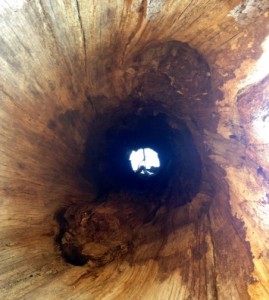
A tree trunk whose heart wood has been devoured by fungus.

Catalpa tree with large wound and fruiting bodies.
One way that nature decomposes an old fallen tree or dead wood is through decay caused by fungus. Fungus not only breaks down logs lying in the woods back into soil, but can also rot a living tree from the inside. When a tree is rotting or decaying from the inside, you will notice mushrooms or conks growing from a lower portion of the trunk or a large injury like a broken branch or large split in the tree. The tree is very capable of healing its self over time, but not quickly enough to keep fungus from invading its heart wood. Heart wood is located in the interior of the trunk and branches. This wood is not living wood, it is wood that was alive at one time but is no longer needed to carry nutrition to parts of the tree. This interior wood is solely for structural support.
Like other fungi, the mushroom-like formations are known as “fruiting bodies.” These fruiting bodies release spores carried by wind, insects, and animals, thereby spreading from tree to tree. Once a tree has an open wound exposing the cambium layer, the tree becomes vulnerable to the fungus spore. The fungus attacks the heart wood on the inside, breaking down the structural support and making the tree weak to wind and breaking. The fungus can move rather quickly and affects most deciduous trees like oaks, maples, poplars, and elms.

This tree was stricken by fungus and felled by wind.
The prevention of heart rot can be a very difficult task, but there are effective measures to minimize damage. These methods include facilitating healthy growth, minimizing wounds, and proper pruning of branches. The bark is the tree’s main defense against disease; reducing the amount of large wounds and bare wood, especially in older trees, helps prevent rot.




